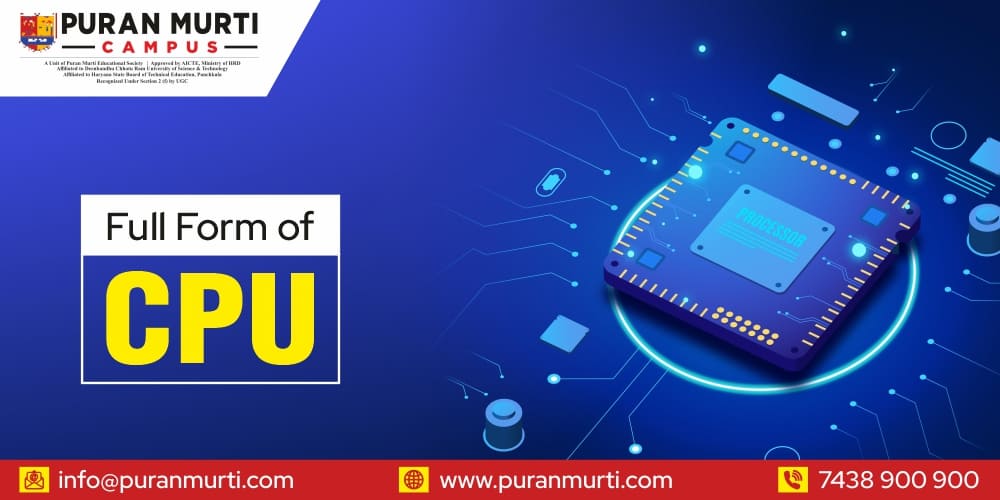Full Form of CPU
Posted on : 4 July, 2025 4:29 pm
Hi there! 👋 Whether you use a laptop, desktop, tablet, or even smartphone, you certainly must have heard the Full Form of CPU. It’s one of those “geeky” terms everyone uses so frequently. But ever wondered:
👉 What does CPU actually stand for?
👉 Why do they call it the “brain” of the computer?
No worries — I’m going to explain it like a friend would, step by step.
✅ What is the Full Form of CPU?
CPU stands for “Central Processing Unit.”
Let’s break that down:
-
Central = at the center of everything
-
Processing = carrying out tasks or calculations
-
Unit = a single component of a bigger system
So essentially, the CPU is the core unit in your system that processes all the instructions, calculations, and operations. Consider it as the “commander” that instructs your computer what to do and when.
🧠 Why Do People Refer to the CPU as the “Brain” of the Computer?
Your brain receives input from your senses, makes choices, and then tells your body what to do. Similarly, the CPU receives commands from your applications (such as a game, a browser, or a video player), processes them, and regulates the computer’s other components so it all operates harmoniously.
Regardless of how high-tech your screen or keyboard may be, your computer is essentially useless without a CPU.
🛠️ What Does a CPU Do, Exactly?
Let’s break it down in simple terms. Every time you:
✅ open an app
✅ type a letter
✅ click a button
✅ play music
✅ watch a video
the CPU is doing its magic behind the scenes, executing millions (even billions!) of small instructions in seconds.
The CPU does four large things repeatedly:
1️⃣ Fetch – pulls an instruction from memory
2️⃣ Decode – determines what that instruction is
3️⃣ Execute – actually does the calculation or work
4️⃣ Store – returns the result to memory
This is done millions of times a second. That’s why the CPU is rated in GHz (Gigahertz) — i.e., how many billions of cycles it can do each second.
🧩 What’s Inside a CPU?
Although a CPU appears to be small from the outside (a small square chip!), it is really very complicated inside. These are its main components:
✨ ALU (Arithmetic Logic Unit):
The one that performs all the mathematical and logic operations — adding, subtracting, comparing numbers, etc.
✨ CU (Control Unit):
Like a traffic cop — it sends all the data, ensuring the proper instructions to the proper places at the proper time.
✨ Registers:
They are similar to little, extremely fast storage containers that store data temporarily while the CPU is processing it.
✨ Cache Memory:
A tiny, lightning-fast memory space within the CPU so it can access frequently-used data without going all the way to RAM.
🔎 What Does a CPU Physically Look Like?
If you’ve ever taken a desktop apart or watched a motherboard video, the CPU tends to be a tiny little square or rectangle chip with thousands of tiny metal pins on the underside (or gold contact pads). You gently set it on the motherboard socket, install a cooling fan on top, and it gets wired to the rest of your PC.
🚀 Types of CPUs
CPUs exist in numerous varieties based on the purpose they serve:
✅ Desktop CPUs – for home or office use
✅ Laptop CPUs – smaller and power-saving
✅ Server CPUs – stronger, to support tremendous data in data centers
✅ Mobile CPUs – constructed for tablets and smartphones
✅ Embedded CPUs – small chips in appliances such as washing machines, automobiles, smart TVs
🌟 How Important is the CPU?
👉 The CPU is the brain of the computer. Without it, nothing functions.
👉 It executes every calculation, every click, every animation you notice.
👉 Contemporary CPUs are incredibly strong — the chip on your phone right now is stronger than a desk-sized computer 20 years ago!
⚡ How is CPU Performance Measured?
Some easy-to-understand terms you’ll hear:
✅ Clock Speed (GHz): how fast in billions of cycles per second the CPU can go
✅ Cores: how many processing units the CPU contains — such as having multiple brains within one chip (quad-core, octa-core, etc.)
✅ Threads: how many tasks the CPU can do simultaneously
✅ Cache: quick storage for the CPU to prevent lag
✅ TDP (Thermal Design Power): informs you of how much heat the CPU emits, so you’ll know how to cool it
A contemporary CPU typically has:
👉 between 4 and 16 cores
👉 8 to 32 threads
👉 rates of 2 GHz to 5 GHz
👉 several MBs of cache
That’s a LOT of power contained in a chip the size of a coin!
🧪 Fun Fact
Did you know? The very first commercially available CPU was Intel 4004 released in 1971 — and it was just a 4-bit processor executing at 740 kHz (less than 1 million cycles per second). Current CPUs execute at billions of cycles per second and possess millions of times more power.🤯
📝 Quick Recap
👉 CPU full form = Central Processing Unit
👉 It is the “brain” of any computing device
👉 Carries out instructions, performs calculations, and manages the entire system
👉 Has components such as ALU, CU, registers, and cache
👉 Exists in many forms and forms (desktop, laptop, mobile, server)
👉 Drives every click, tap, or swipe you make

